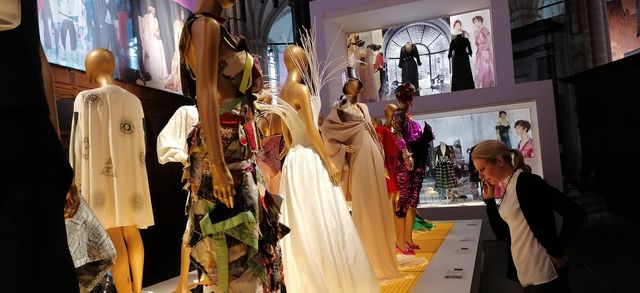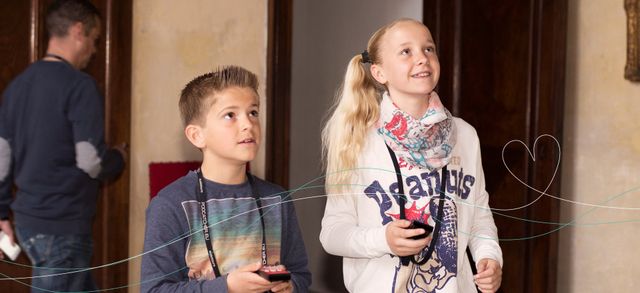A plea against smartphones in museums
Frits Polman • may 19, 2022
Image copyright © Guide-ID
My social media regularly features posts from companies that make apps for museums. Apps that promise heaven and earth, with the-sky-is-the-limit vibes. And to experience all this goodness, all you need is a smartphone. It’s a smartphone utopia for museums and visitors alike. However, now that I’m armed with a good two decades of experience in the museum sector, I feel it’s time to dissect those utopian promises.
I should start by saying I get what the developers of those apps are trying to achieve. Virtually everyone nowadays has a smartphone, so why not add ‘multimedia guide’ to its many functions? It would mean companies no longer have to invest millions in developing their own ‘players’, nor would they have to worry about the logistics of supplying and maintaining them. What is there not to like? And since everyone is glued to their smartphone all day anyway, it’s only natural that they would do the same in a museum setting. Right?
Detracting from the experience
However, that’s where the first mistake is made. Think about the last time you visited a museum. Why did you choose to visit? Probably because you wanted to see an exhibition and specific objects or works of art. You’d seen it all online, but now you wanted to experience it in real life – up close, letting your eyes wander over the painting, taking it all in. Bam! That’s the power of real, authentic art. Give me one good reason why you’d interrupt this magical event by picking up your phone to find out more about the art. You know how it goes: you’re on your phone, so you might as well check Facebook or answer that LinkedIn message.

Image copyright © Guide-ID
It’s become a familiar sight. People open their smartphone, their eyes fixate on the screen, and they drift off. They’re in a virtual world; the museum’s magic is lost. I think it shouldn’t be this way. Many of the museum apps contain an overwhelming amount of information. While this is fantastic if you’re at home or on the go, it’s a huge distraction when you’re physically at the museum. Standing in front of a piece of art, the most you want is a concise story about the work itself, and that story should be audio, so your eyes can stay focused on the work of art. You don’t need endless background information, information about other exhibitions, or complicated menu structures that you have to untangle before finding the information you want. You want to use your eyes to look at the art – not at your smartphone screen.
Waving your smartphone in the air
And then there’s the way content is activated. More and more companies are using automated image recognition: point your smartphone at a painting, and all the information pops up on your screen. It couldn’t be easier. But how do you know which painting has more information? Or will the museum provide information for every single object or work on display? If they don’t, and you point your smartphone at a piece of art but nothing happens, you’re likely to stop using the app. Besides that, I can’t help but see parallels between scanning paintings and what people often do at concerts nowadays: all waving their smartphone in the air in an attempt to film the performance. It’s not my idea of the perfect concert or museum visit.
Audio-only
I can hear you saying: ‘I get it, Frits. But the apps do offer something very practical – a map on your smartphone, so you don’t get lost.’ You’d be right, and I’d have to agree. If you’re afraid of getting lost and having to spend the night in the shadowy halls of the museum, I recommend downloading a map as soon as you walk through the doors. I’ll be clear about using smartphone screens for films and photos: when I first got into multimedia guides back in 2004, I also thought it was a fantastic idea. However, curators and museum staff kept reminding me that visitors have the most intense experience when they’re looking at the art rather than at a screen. That’s why we’ve been doing audio-only since 2009. Our success speaks for itself...

Image copyright © Guide-ID
Despite this, we also offer an app for smartphones and a mobile website. There are two reasons for this. The first: is self-protection. Some companies make it seem as if apps are the panacea to every single problem a museum might face. Sometimes, not having an app is enough for a prospective customer to reject you outright, leaving you no opportunity to paint a realistic picture. The second: comparing the use of our own app and mobile website with the Podcatcher (our flagship), we can provide data that shows the Podcatcher offers a better experience than a smartphone. That knowledge is a real eye-opener for museums.
Not for everyone
Finally, I’d like to comment on the scope of smartphone use in museums. Not all visitors have a smartphone – school groups are one example. And the visitors who do have one don’t always have the latest updates and technology. For example, our new Podcatcher uses Ultra-Wideband (UWB), so we can visualize accurate walking routes and provide the right information at the right times. However, this is only available from iPhone 13 (if Apple releases it for third parties). It can sometimes take years for the latest technology to catch on with the majority of museum visitors, not least because the average age of museum visitors is 50 plus. And then there’s the argument about your smartphone battery: who wants to be left with an empty phone after two hours at a museum?
Case closed
So, we’ve come full circle. It’s all about using technology to provide visitors with a magical moment in front of authentic objects and art without being distracted. For our customers, we compare the experience of visitors who use their smartphone with the experience of visitors who use the Podcatcher. Time and time again, we see that the best experience is the non-distancing experience. That’s exactly what we offer with the Podcatcher. Case closed...
List of Services
-
Meet The Beacons: The Little Traffic Controllers of Your Exhibition Have you ever noticed when you’re wandering through an exhibit the museum audio guide in hand and suddenly the tour starts activating on it’s own and the narration begins to play — feels like magic, right? But there’s actually a technology behind it. Spoiler: it’s not Wi-Fi, and it’s not magnetic attraction either (well… kind of).Meet The Beacons: The Little Traffic Controllers of Your Exhibition
-
What Would Be the Best Tour Guide System for Groups? Tourism is booming. No matter where you go, every place has a story to tell. Millions of people around the world are eager to dive into adventure and uncover the secrets of towns, landmarks, museums, nature parks, and more. Whether on foot, by bus, or by boat, everyone is excited to explore.What Would Be the Best Tour Guide System for Groups?
-
How to Increase Museum Engagement with AudioHow to Increase Museum Engagement with Audio
TIPS and TRICKS Gaining real engagement today can be a challenge for museums and cultural spaces. The diversity of languages, ages, and interests makes it difficult to find the right approach for each visitor, and to truly connect with them.
But, how can museums improve engagement and offer visitors a truly memorable experience? There are several important factors to consider, such as identifying your audience, choosing the right type of content, determining the ideal tour duration, and selecting appropriate vocabulary and tone for narration.
So today, we’ve put together some helpful tips and tricks to show you the best ways to achieve real engagement in your space.
TIPS and TRICKS -
Guide-ID’s Ultimate Duo:
When hardware and software merge their super powers Batman and Robin, Mario and Luigi, Sherlock and Watson, Han Solo & Chewbacca—what do they have in common? They’re some of the most iconic duos of all time. And today, we have a new one to add to the list. Ready? Drums please… The Podcatcher Pro & Its Tour Editor Platform!
Guide-ID’s Ultimate Duo:
When hardware and software merge their super powers -
AI Meets Audio: How Guide-ID Is Helping Museums Rethink Tour Creation From faster workflows to multilingual storytelling, Guide-ID’s smart AI tools are changing the way museums engage their visitors.AI Meets Audio: How Guide-ID Is Helping Museums Rethink Tour Creation
-
House of Bols: Telling a 450-year-old story with modern tech Just around the corner from Museumplein in Amsterdam, is House of Bols the Cocktail & Genever Experience, a multisensory space that brings to life the fascinating story of one of the world’s oldest distilled spirit brands. Through immersive storytelling, visual design, aromas, and sound, visitors step into the vibrant world of Bols, which has been crafting flavors since 1575.House of Bols: Telling a 450-year-old story with modern tech